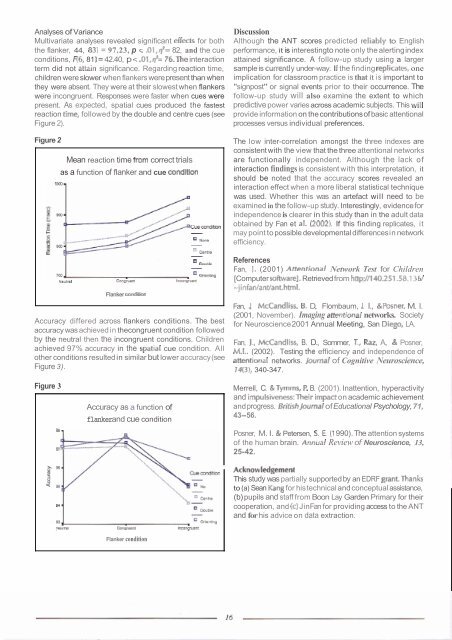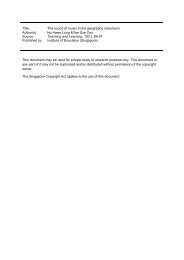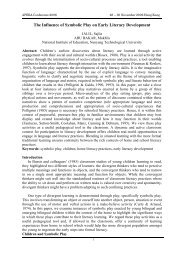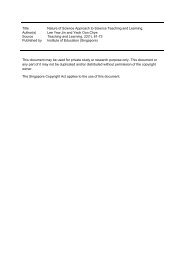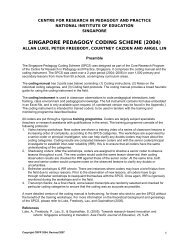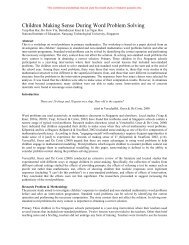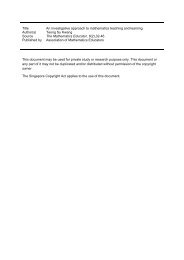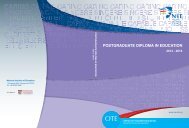Future EBuczttIomI Research: The - NIE Digital Repository - National ...
Future EBuczttIomI Research: The - NIE Digital Repository - National ...
Future EBuczttIomI Research: The - NIE Digital Repository - National ...
Create successful ePaper yourself
Turn your PDF publications into a flip-book with our unique Google optimized e-Paper software.
Analyses of VarianceMultivariate analyses revealed significant effects for boththe flanker, 44, 831 = 97.23, p < .01,4= 82, and the cueconditions, F(6, 811 = 42.40, p < .Dl,#= 76.<strong>The</strong> interactionterm did not attain significance. Regarding reaction time,children were slower when flankers werepresent than whenthey were absent. <strong>The</strong>y were at their slowest when flankerswere incongruent. Responses were faster when cues werepresent. As expected, spatial cues produced the fastestreaction time, followed by the double and centre cues (seeFigure 2).Figure 2Mean reaction time from correct trialsas a function of flanker and cue mnditionNmutral w r ~ m 1-Flanker condiiCuecrrrdim-n~ane---zrmmDoubkOriemingAccuracy differed across flankers conditions. <strong>The</strong> bestaccuracy was achieved in thecongruent condition followedby the neutral then the incongruent conditions. Childrenachieved 97% accuracy in the spatiaI cue condition. Allother conditions resulted in similar but lower accuracy(seeFigure 3).DiscussionAlthough the ANT scores predicted reliably to Englishperformance, it is interestingto note only the alertingindexattained significance. A follow-up study using a largersample is current1 y under-way. If the finding replicat~, oneimplication for classroom practice is that it is important to"signpost" or signal events prior to their occurrence. <strong>The</strong>follow-up study will also examine the extent to whichpredictive power varies across academic subjects. This willprovide information on the contributionsof basic attentionalprocesses versus individual preferences.<strong>The</strong> low inter-correlation amongst the three indexes areconsistent with the view that the three attentional networksare functionally independent. Although the lack ofinteraction findings is consistent with this interpretation, itshould be noted that the accuracy scores revealed aninteraction effect when a more liberal statistical techniquewas used. Whether this was an artefact will need to beexamined in the follow-up study. Interestingly, evidenceforindependenceis clearer in this study than in the adult dataobtained by Fan et al. (2002). If this finding replicates, itmay point to possible developmental differencesin networkefficiency.ReferencesFan, J. (2001) Aflenfional Network Test for Children[Computer softwarel. Retrievedfrom httpj/l40.251.58.13 6/-jinfan/ant/ant.htrnl.Fan, J., McCandliss, 6. D., Flombaum, J. I., &Posner, M. I.(2001, November). Imaging attentionai networks. Societyfor Neuroscience2001 Annual Meeting, San Diega, LA.Fan, J., McCandliss, B. D., Sommer, T., Raz, A., & Posner,M.I.. (2002). Testing the efficiency and independence ofattentional networks. Journal of Cognitive Neuroscience,14(3), 340-347.Figure 3mWAccuracy as a function offlankerand cue conditionMerrell, C. &Tymrns, P. B. (2001). Inattention, hyperactivityand impuIsiveness:<strong>The</strong>ir impact on academic achievementandprogress. British/ournal ofEducational Psychology,71,43-56.Posner, M. I. & Petersen, S. E. (1990).<strong>The</strong> attention systemsof the human brain. Annual Review of Neuroscience, 13,25-42.Y93.N-ConprwntFlanker condition~cknowled~ementThis study was partially supportedby an EDRF grant.Thanksto (a) Sean Kang for histechnical and conceptual assistance,(b)pupils and staff from Boon Lay Garden Primary for theircooperation, and (c) JinFan for providing access to the ANTand for his advice on data extraction.


